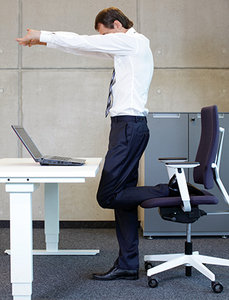I'm more than a bit confused. At my age, that seems to be a rather common occurrence. However, today more than ever, I'm getting a mixed message. Let me explain.
Much of the increase that occurred can be credited to a better infrastructure (e.g., safe drinking water, refrigerated food) and better medical care (e.g., antibiotics, vaccinations). Much of the recent decline can probably be attributed to our lifestyle (e.g., diet and physical activity).
No longer are we as likely to die at a young age from the effects of an injury or infection. Instead, we are living longer and are more likely to suffer from chronic, degenerative diseases. It has been said that we're now living long enough to get sick.
It is relatively clear that there is a relationship between lifestyle and the development of chronic diseases such as diabetes and heart disease. The more we eat and the less we exercise, the more we are likely to weigh and the greater the chances of developing one of these diseases. In the words of American composer and jazz artist Eubie Blake, "If I'd known I was going to live this long, I'd have taken better care of myself."
The Sitting Factor: Disease and Our Sedentary Lifestyles
 A few years ago (October 2013), I wrote about the health effects of prolonged sitting.1 In that column, I cited an article by van der Ploeg (2010), who found that sitting for 11 hours or more each day increased the risk of death by 40 percent compared to sitting less.2 And that was in spite of other activity levels. If we add up the time spent sitting at our desk at work, commute time and time spent in front of the television, 11 hours is a number that's pretty easy to come up with.
A few years ago (October 2013), I wrote about the health effects of prolonged sitting.1 In that column, I cited an article by van der Ploeg (2010), who found that sitting for 11 hours or more each day increased the risk of death by 40 percent compared to sitting less.2 And that was in spite of other activity levels. If we add up the time spent sitting at our desk at work, commute time and time spent in front of the television, 11 hours is a number that's pretty easy to come up with.
In the past, I also provided tips to encourage standing at work. And I'm not the only one who thinks standing is a good alternative to prolonged sitting. A number of others have stated the same thing: Sitting is hazardous to your health.
Writing in the Journal of Preventive Medicine, Richard Pulsford and colleagues claim there is an association between time spent sitting and obesity risk.3 Simply put, the longer one sits, the heavier he is likely to become.[As an aside, working from an upright position (standing) has been shown to use 40 percent more calories than sitting.]
Sitting has even been called "the new smoking."4 As such, it is known to have a detrimental effect on health. Every cigarette smoked reduces the life expectancy of the smoker. In a similar manner, for every hour one sits, life expectancy is reduced.
Too Much Sitting Is Bad ... Too Much Standing Is Bad?
With that in mind, two articles in the Los Angeles Times caught my attention. Both in the April 4 issue, one was titled "A Warning on Obesity, Life Spans" the second: "California's Top Court Tells Employers to Give Workers a Chair."
The first article discusses the rising obesity epidemic and the impact it has on life expectancy. The article quotes Dr. David S. Ludwig, an obesity prevention specialist at Boston Children's Hospital. He states there is a clear link between the food we eat, the activity we get and obesity-related deaths.
The Centers for Disease Control and Prevention (CDC) concurs. The CDC states that currently, one-third of American adults are obese; that by the year 2030, half of all Americans will be obese; and that one in every six children and adolescents is obese.
As stated earlier, much of this change can be blamed on our diet and our lack of physical activity. Let's face it: Our food isn't getting better. There's been an increase in our portion size and a decrease in quality: too much salt, sugar, and fried foods. Fast food seems to be the order of the day.
I even saw an advertisement recently that promoted "The fourth meal" – apparently the meal between dinner and breakfast. As if we need another meal!
Additionally, we're not becoming more active. The American Heart Association says even moderate activity (e.g., brisk walking) may be beneficial when done regularly. The AMA defines that as 30 minutes or longer at least five days each week. But how many of us do that? Fitting 30 minutes of exercise into our already busy schedules isn't easy.
The second Times article discusses a decision by the California Supreme Court mandating that employers must allow their employees an opportunity to sit on the job. We seem to have something of a mixed message here. Sitting adds to obesity and obesity leads to many chronic diseases. So, the court tells employers they have to allow their employees to sit at work. Hmm...
I recognize what the court was attempting to do. Workers who must stand all day (e.g., clerks at a check-out stand) are subject to a variety of ailments. The court is simply trying to give them a choice. If work can be done while the worker is seated, why not provide chairs?
UCLA provides the following suggestions for times when sitting is preferable to standing:5
- When the job task cannot be done with the arms comfortably at the sides
- When working on products that are greater than 6 inches high or more than 10 pounds in weight
- When the work requires more than one workspace
- When the work task lasts less than 5 minutes
- When the work surface does not allow the worker to comfortably position their legs under the work surface
- When tasks require the frequent application of downward pressures
Trending: The Upright Workspace
Ironically, while the California Supreme Court has decided employers need to allow sitting at work, one of the trends in many workplaces is to encourage workers to stand while they work. Hence, the rise in interest in such things as the standing desk. Some have even gone so far as to put laptop computers on treadmills.
Keep in mind that while sitting for long periods has been shown to be bad for you, standing in place is no panacea, either; especially when workers must stand at a checkstand or similar location for hours on end. Standing for long periods may lead to such things as varicose veins, muscle fatigue and back pain.
But in general, employers (and the courts) shouldn't encourage workers to sit. Instead, workers should be encouraged to move around and to vary their time from sitting to standing. Perhaps seated work should come with a warning sign, something like that placed on a pack of cigarettes.
Movement Is the Key
It would appear that prolonged sitting and prolonged standing can be detrimental to our health. The key, therefore, is to build movement into the workspace and the workday. Workers should be encouraged to move around as much as possible. Whenever possible, they should be provided sit-stand chairs that enable them to go from a seated position to standing with ease.
References
- Hooper P. "Sit or Stand? Strategies to Improve Workplace Health and Reduce Disease." Dynamic Chiropractic, Oct. 1, 2013.
- Van der Ploeg HP, Chey T, Korda RJ, Banks E, Bauman A. Sitting time and all-cause mortality risk in 222,497 Australian adults. Arch Intern Med, 2010 Mar 26;172(6):494-500.
- Pulsford RM, Stamatakis E, Britton AR, Brunner EJ, Hillsdon MM. Sitting behavior and obesity: evidence from the Whitehall II Study, J Preventive Med, 2013 Feb;44(2):132-8.
- Sturt D, Nordstrom T. "Is Sitting the New Smoking?" Forbes, Jan. 13, 2015.
- UCLA Ergonomics: Standing vs. Sitting at Work. University of California, Los Angeles - Environment, Health and Safety.
Click here for previous articles by Paul Hooper, DC, MPH, MS.





